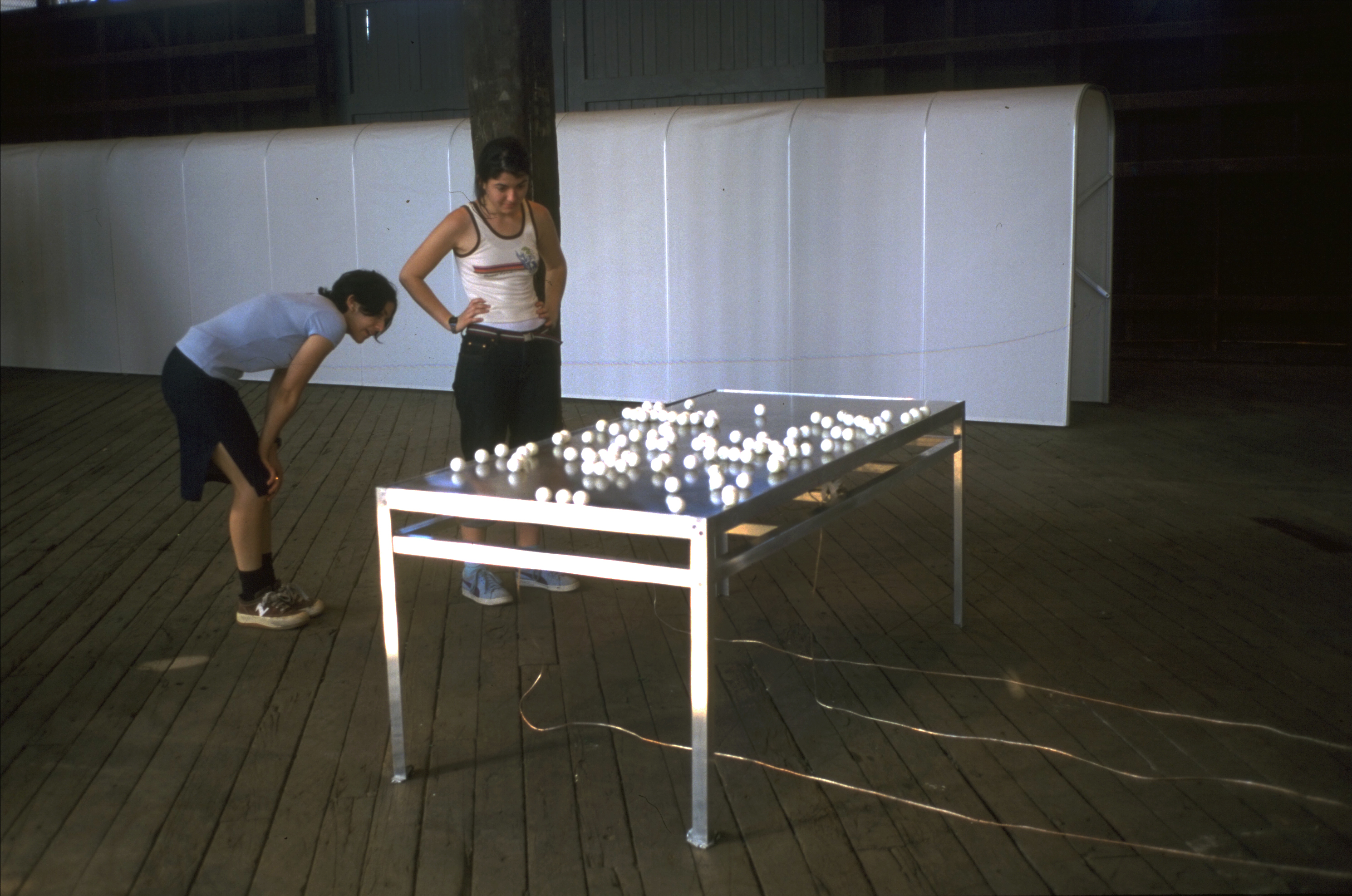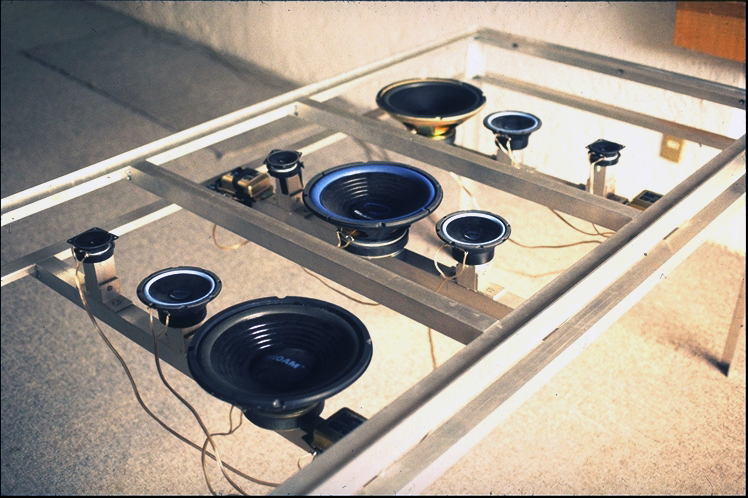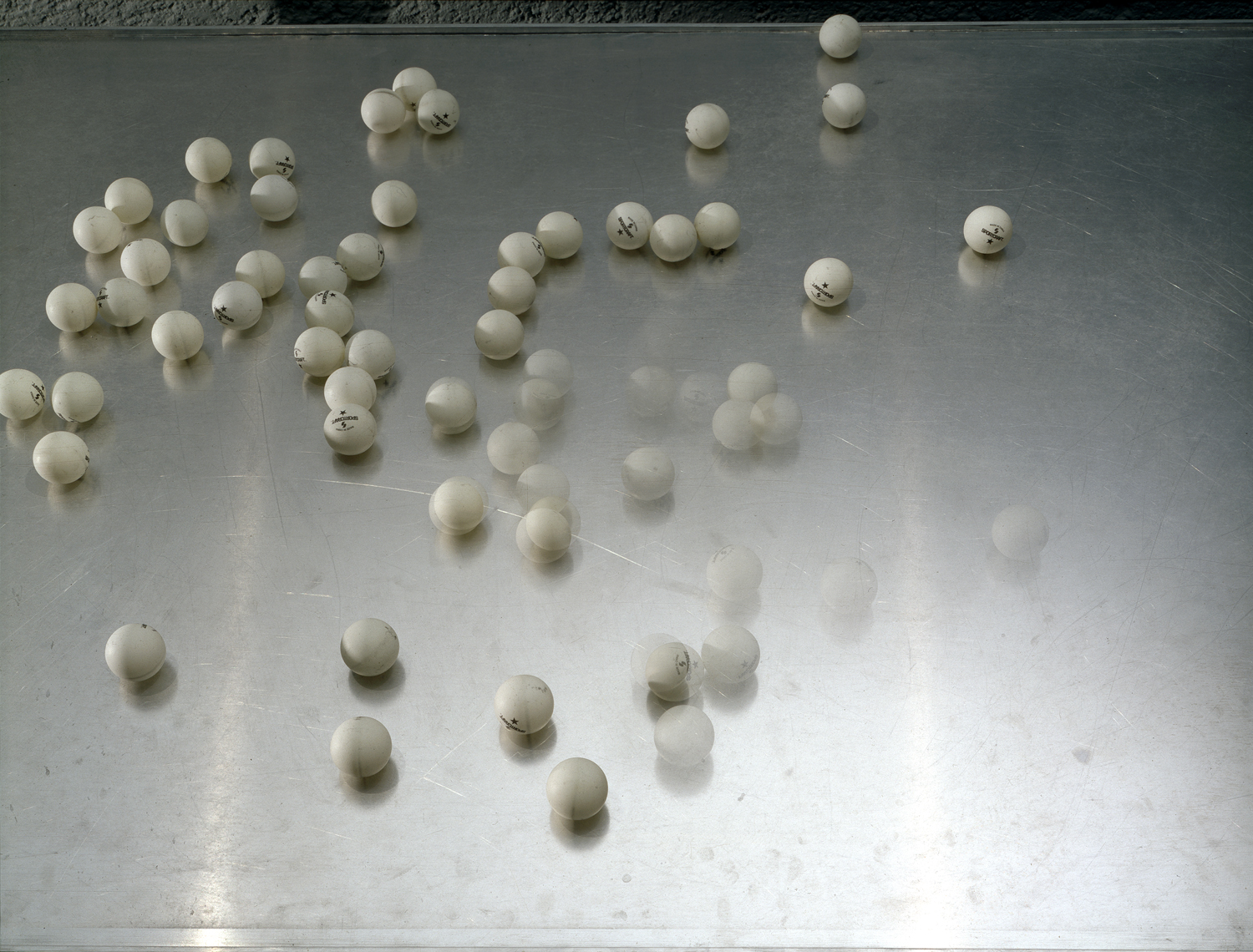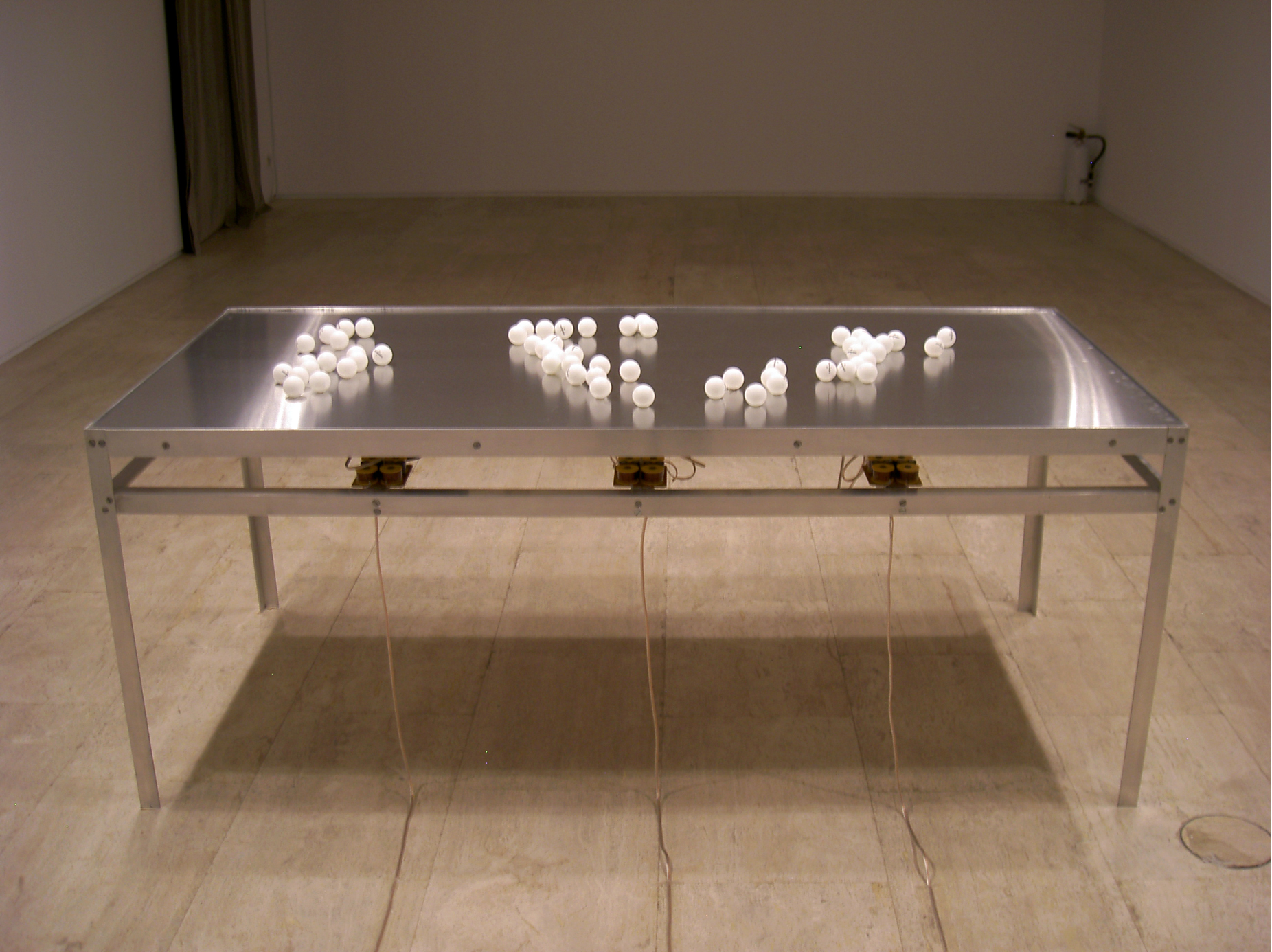 |
Ping Roll excerpt
PING ROLL 1997

Ping Roll. Biennale of Sidney Australia. September 1998.
 |
Ping Roll excerpt
PING ROLL 1997

Ping Roll. Biennale of Sidney Australia. September 1998.
This sound sculpture has 3 series of speakers that play 3 tracks with the sound of processes of Ping-Pong balls bouncing stochastically, alternating with periods of silence, and with pure sinusoidal frequencies. The sound of each track alternates between each other so that the speakers sound at different times. The sinusoidal frequencies diffused through the speakers were calculated in order to be sympathetic to the natural tuning of the sculpture’s aluminum plate, so that they make it vibrate and resonate. The effect of the vibrating plate over the Ping-Pong balls is that some of them bounce in a fixed point, while others get out of their bouncing orbit and slide through the surface of the plate.
The primordial function of a Ping-Pong ball is to bounce -a discontinuous movement-, but the law of gravity could make a ball to bounce every time faster, and eventually to produce tone frequencies -a continuous movement-. Metaphorically, the fact that the continuous sinusoidal tones causes the real balls to bounce or roll over the plate, while the actual sound of discontinuous bouncing produces stasis, represents a sort of paradox where the two opposite states of the ball, the discontinuous (bouncing) and the continuous (rolling) are in reality both part of one same phenomena. This metaphor is related to the quantum theory where light can behave either as particles (discontinuity) or as waves (continuity). Acoustically speaking, the discontinuous bouncing represents rhythm and the fast bouncing represents frequency. We have in this way a dialectic or game of opposite states generated by these two essential elements of sound.
The duration of the sound sequences corresponds to the structure of the logarithmic bouncing of a Ping-Pong ball while we drop it over a hard surface. The ball bounces every time faster affected by the laws of gravity and friction. I used a constant ratio (.666) related to the golden mean, as a multiplying factor that decreases the duration’s of the bouncing sounds, of the silences, and of the sinusoidal frequencies; there is also a progression where the bouncing sounds start with a slow rate and get every time faster, and where the sinusoidal tones start with very low frequencies and then increase gradually in frequency. At one point of the process, there isn’t any more silence between the sounds, and they start to overlap, arriving to a climax zone made out from fast bouncing sounds and high sinusoidal frequencies. After this climax there is a backwards mirror of the process where the sounds and silences start to get longer again. The whole process lasts for 38 minutes and 15 seconds.
Besides the dialog established between discontinuous and continuous movement, the sound sculpture itself is a sort of chaotic game. We start the game by spreading all the balls over the table homogeneously and equidistant one from each other. This is a very improbable ordered state. The balls will then start to move and will tend to go to certain zones of the table which I call entropy zones, because the balls move less and less every time, and after a little while they always stay near this zones. We have here an example of the chaotic phenomena of "sensitive dependence on initial conditions". Amazingly, the different configurations formed by the movement of the balls will vary greatly even if we have at the beginning exactly the same volume level, and the same starting positions for the balls. At the end of the whole process, we have to spread the balls again equidistantly and wait to see a new entropy process that will go from order to chaos.

Detalle de la estructura de las bocinas debajo de la lámina - Detail of speaker structure under the aluminum plate
Esta escultura sonora consta de una plancha rectangular con bordes (.90 x 1.90 cm), hecha de laminas delgadas de metal y montada sobre cuatro patas. Es decir, una especie de mesa, como si se tratara de un juego. Sobre esta plancha hay 70 pelotas de ping pong, y en la base inferior de la plancha hay 3 series de bocinas (Woofer, medio y twitter * 3) haciendo contacto con ella. Las bocinas están conectadas a 2 CD tereo. Cada CD tiene grabadas dos pistas con el ruido del rebote de una pelota de ping pong que se acelera y se desacelera, con rebotes completamente discontinuos, y con sonidos de frecuencias continuas; el principio acústico de una repetición rápida continua produce un número determinado de periodos por segundo, equivalentes a una frecuencia específica. Por ejemplo, 100 rebotes por segundo equivale a una frecuencia de 100 Hz, aproximadamente un sol#. El sonido grabado en cada pista efectúa un proceso entre rebotes discontinuos y frecuencias continuas. Los procesos de los rebotes están alternados con silencios, de manera que las 3 series de bocinas casi nunca suenan al mismo tiempo. Como uso 2 CD's grabados, puedo utilizar la función random de los reproductores de CD para que exista un factor aleatorio que afecte la ejecución de los índices (tracs) de los 2 discos, de éste modo, existe la posibilidad de que las bocinas que suenen vayan cambiando, de que no suene ninguna bocina, o de que suenen todas las bocinas al mismo tiempo. La idea de que las bocinas estén pegadas a la parte inferior de la plancha de lámina es que la plancha vibre, y de este modo, que la vibración haga que las pelotas de ping pong rueden sobre ella.
La función primordial de una pelota de ping pong es la de rebotar, un movimiento discontinuo. El hecho de que una frecuencia continua haga que las pelotas reboten o rueden sobre la mesa constituye una paradoja, ya que por otro lado, el sonido discontinuo de las pelotas no produce ningún efecto. Los dos estados de la pelota, el del rebote discontinuo y el del rebote continuo, son ambos intrínsecos a la pelota e indisociables. Este fenómeno es equivalente a la teoría cuántica en la que la luz puede comportarse tanto de manera ondulatoria (continuidad) como en forma de partículas llamadas fotones (discontinuidad). Acústicamente hablando, el rebote discontinuo representa ritmo y un rebote rápido continuo representa frecuencia. Tenemos entonces también una dialéctica o juego que se establece entre los dos elementos esenciales del sonido.
Además del diálogo que establezco entre un estado discontinuo y uno continuo, la escultura en sí es una especie de organismo con vida o instrumento musical que recuerda procesos estocásticos que suceden en la naturaleza, como por ejemplo el ritmo de los insectos que abecés es continuo y abecés discontinuo. Por otro lado, el movimiento físico de las pelotas sobre la mesa es una respuesta al movimiento acústico de las bocinas. De esta manera existen dos mundos en paralelo que interactúan, uno sonoro que nos lleva a lo imaginario, y uno visual que nos lleva a lo sonoro (el ruido de las pelotas rodando en la lamina).
El proyecto de ésta escultura sonora fue seleccionado para la primera bienal tridimensional organizada por el INBA y el CNA, la muestra se inauguró el 27 de Abril de 1997 en el CNA. También fue seleccionado para presentarse en la 11va Bienal de Sídney en Australia en Septiembre de 1998. Luego en la exposición Dimensión Sonora en el Koldo de Mixtelena en San Sebastián España en 2007. Finalmente fue donada a la colección del Museo de Arte Contemporáneo (MUAC) de la UNAM en 2016, y expuesta luego de 20 años de no haber sido exhibida en México en la exposición Reverberaciones en 2017 en el museo MUAC, una muestra de arte sonoro a partir de las obras de su colección.

Detalle de las bolas distribuidas de manera caótica en la mesa - Detail of balls distributed in a chaotic way over the table

Ping Roll. Dimensión Sonora Koldo de Mixtelena, San Sebastián España, 2007.